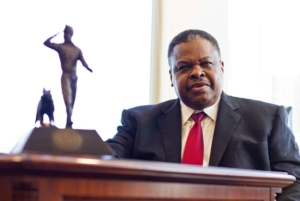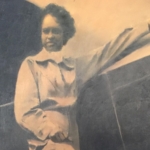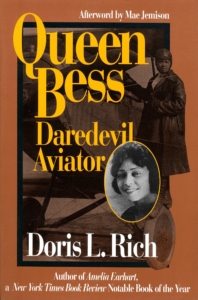Enslaved Couples Faced Wrenching Separations, or Even Choosing Family Over Freedom
Loved ones could be sold away at any time. Here’s how married couples coped.
Photo: Soldier and Companion, c.1861-65 (tintype with brass mat & leather case), American Photographer, (19th century)/Detroit Institute of Arts, USA/Founders Society Purchase, DeRoy Photographic Acquisition Endowment Fund and Coville Photographic Fund/Bridgeman Images
(History.com) For enslaved African-Americans, the ideal of marriage as an enduring lifelong bond was rarely an option. When couples stood before clergy or other officiants, they couldn’t share the traditional, age-old promises of permanent fidelity because their vows had a built-in asterisk: “Do you take this woman or this man to be your spouse—until death or distance do you part?”
Understanding those altered words, couples married with trepidation, fully aware of the turmoil that might result from trying to maintain and nurture their ties while enslaved. Still, they continually took leaps of faith, driven by burning passions to form families of their choosing—and create fundamental human bonds that could help soften the harsh conditions of human bondage.
These leaps were necessary because, for nearly 250 years, the vast majority of African-Americans were considered chattel property. Within this system, white slaveholders made all the decisions: They determined whether and when enslaved people could wed. They split them apart when finances dictated. They sometimes chose who would marry who. Or brazenly violated enslaved couples’ marriages by forcing the women to serve as their own concubines. And those in political power set laws that made it exceedingly difficult for freed black people to reside for long near their still-enslaved families without being sucked back into the harrowing state of bondage themselves.
Since marriage was both a civil right and a religious rite afforded only to those with legal standing, enslaved people, who had no recognizable standing in society, could not make contracts of any kind. Their marriages were neither legally binding, nor sanctified by the Christian church, which routinely allowed one of its holiest rites to be tarnished by power, money and whim. Property owners were its leading constituents, and their rights prevailed over human rights. So enslaved people were forced to settle for conditional unions that could be torn asunder at any time. (more)
Decades After Racial Strife, Returning to A&M
Forty-five years ago, Bill Mahomes endured suspicion and scorn as the first black student to graduate from Texas A&M University’s Corps of Cadets. Now, he helps run the school.

Bill Mahomes in his office at Mahomes & Bolden PC in Dallas. Mahomes was the first black cadet to make it through the Texas A&M Corps of Cadets and is now a member of the Texas A&M System Board of Regents. (Mark Graham)
(Texas Tribune) Two decades after becoming the first black student at Texas A&M to spend four years in the school’s Corps of Cadets, Bill Mahomes received a call from an old classmate. They hadn’t spoken since graduation, but the man wanted to apologize.
He had screamed at Mahomes once – not uncommon in A&M’s massive, ROTC-like military program. But this instance had crossed the line. Words were too harsh. Racial slurs may have been used. The incident had weighed on the classmate ever since.
Mahomes listened to the apology but didn’t know what to say. At first, he couldn’t even remember the incident. That kind of thing happened so often at A&M in the 1960s that he usually endured it and moved on.
The apology, however, left a more lasting impression. Looking back, the 68-year-old lawyer says, it was one of many healing moments that helped him reconnect with his university — a school he kept his distance from after graduating during the painful civil rights era. (more)
Azellia White, trailblazer for African-American women in aviation, dies at 106
Native of Gonzalez, Texas
 (The Washington Post) Azellia White, who said she found freedom in the skies, becoming one of the first African American women to earn a pilot’s license in the United States, died Sept. 14 at a nursing home in Sugar Land, Tex. She was 106.
(The Washington Post) Azellia White, who said she found freedom in the skies, becoming one of the first African American women to earn a pilot’s license in the United States, died Sept. 14 at a nursing home in Sugar Land, Tex. She was 106.
Her death was reported Nov. 18 in the London Daily Telegraph but had previously gone largely unnoted in the U.S. and international news media. A great-niece, Emeldia Bailey, confirmed her death and said she did not know the cause.
Mrs. White, the daughter of a sharecropper and a midwife, was drawn to aviation by her husband, Hulon “Pappy” White, a mechanic who served during World War II in Tuskegee, Ala., as a mechanic for the storied unit of black military pilots known as the Tuskegee Airmen. (more)
TIPHC Bookshelf
 Published scholarship on black history in Texas is growing and we’d like to share with you some suggested readings, both current and past, from some of the preeminent history scholars in Texas and beyond. We invite you to take a look at our bookshelf page – including a featured selection – and check back as the list grows. A different selection will be featured each week. We welcome suggestions and reviews. This week, we offer, “Queen Bess, Daredevil Aviator,” by Doris L. Rich.
Published scholarship on black history in Texas is growing and we’d like to share with you some suggested readings, both current and past, from some of the preeminent history scholars in Texas and beyond. We invite you to take a look at our bookshelf page – including a featured selection – and check back as the list grows. A different selection will be featured each week. We welcome suggestions and reviews. This week, we offer, “Queen Bess, Daredevil Aviator,” by Doris L. Rich.
Here is the brief but intense life of Bessie Coleman, America’s first African American woman aviator. Born in 1892 in Atlanta, Texas, she became known as “Queen Bess,” a barnstormer and flying-circus performer who defied the strictures of race, sex, and society in pursuit of a dream.
This Week in Texas Black History
Nov. 17
 Basketball player Elvin Hayes, one of the first black athletes at the University of Houston, was born on this day in 1945 in Rayville, La. Hayes was a three-time All-America and was selected as the College Player of the Year in 1968. As a pro, he was the first pick in the 1968 NBA draft by the San Diego (later Houston) Rockets, and would also star for the Baltimore/Washington Bullets. Hayes retired in 1984 as the second-leading scorer in league history with 27,313 points, was inducted into the Naismith Memorial Basketball Hall of Fame in 1990, and was named one of the NBA’s 50 greatest players in 1996.
Basketball player Elvin Hayes, one of the first black athletes at the University of Houston, was born on this day in 1945 in Rayville, La. Hayes was a three-time All-America and was selected as the College Player of the Year in 1968. As a pro, he was the first pick in the 1968 NBA draft by the San Diego (later Houston) Rockets, and would also star for the Baltimore/Washington Bullets. Hayes retired in 1984 as the second-leading scorer in league history with 27,313 points, was inducted into the Naismith Memorial Basketball Hall of Fame in 1990, and was named one of the NBA’s 50 greatest players in 1996.
Nov. 23
 On this day in 1963, Baylor University’s athletic council announced it would integrate all of the school’s athletic teams, effective with the opening of the spring semester, Jan. 30, 1964. At the time, the school had no black students, but had announced its intention to open enrollment. John Bridgers, head football coach and athletic director said, “We don’t know of any Negro athletes right now that we’re interested in, but there may be some we will want to look at and investigate…there are some tremendous Negro athletes all over the country.” Bridgers said he personally agrees with the action of the trustees and the athletic council. “I feel it’s something that should be, from a standpoint of being right.” Ironically, Baylor was the first program in the Southwest Conference to have a black player take the field when running back John Westbrook, a walk-on, carried the ball twice in the Bears victory over Syracuse University on Sept. 10, 1966. A week later, Southern Methodist University‘s Jerry Levias became the SWC’s first black scholarship player.
On this day in 1963, Baylor University’s athletic council announced it would integrate all of the school’s athletic teams, effective with the opening of the spring semester, Jan. 30, 1964. At the time, the school had no black students, but had announced its intention to open enrollment. John Bridgers, head football coach and athletic director said, “We don’t know of any Negro athletes right now that we’re interested in, but there may be some we will want to look at and investigate…there are some tremendous Negro athletes all over the country.” Bridgers said he personally agrees with the action of the trustees and the athletic council. “I feel it’s something that should be, from a standpoint of being right.” Ironically, Baylor was the first program in the Southwest Conference to have a black player take the field when running back John Westbrook, a walk-on, carried the ball twice in the Bears victory over Syracuse University on Sept. 10, 1966. A week later, Southern Methodist University‘s Jerry Levias became the SWC’s first black scholarship player.
Blog: Ron Goodwin, Ph.D., author, PVAMU history professor
Ron Goodwin is an assistant professor of history at Prairie View A&M University. Even though he was a military “brat,” he still considers San Antonio home. Like his father and brother, Ron joined the U.S. Air Force and while enlisted received his undergraduate degree from Texas Lutheran University in Seguin, Texas. After his honorable discharge, he completed graduate degrees from Texas Southern University. Goodwin’s book, Blacks in Houston, is a pictorial history of Houston’s black community. His most recent book, Remembering the Days of Sorrow, examines the institution of slavery in Texas from the perspective of the New Deal’s Slave Narratives.
Recent Posts
Football is still football
October 14th, 2019
Since we’re into the football season I thought it was time to interject my two cents. I’ve noticed several teams starting black quarterbacks these days. Some because of injury, but others have been under center since training camp. By my count, the first weekend of the National Football League season in September saw nine African…(more)
1960s Revisited
Over the last few years our society has spent a great amount of energy reliving and analyzing the 1960s. Every event – from the deaths of the Kennedy brothers, MLK and Malcolm X, landing on the moon, war protests, and the hippie revolution – has been scrutinized through the microscope of history. The interesting thing about history’s microscope, though, is that it often blots out the nasty and the ugly. The concept of revisionism centers…(more)
Submissions wanted
Historians, scholars, students, lend us your…writings. Help us produce the most comprehensive documentation ever undertaken for the African American experience in Texas. We encourage you to contribute items about people, places, events, issues, politics/legislation, sports, entertainment, religion, etc., as general entries or essays. Our documentation is wide-ranging and diverse, and you may research and write about the subject of your interest or, to start, please consult our list of suggested biographical entries and see submission guidelines. However, all topics must be approved by TIPHC editors before beginning your research/writing.
We welcome your questions or comments. Please contact Michael Hurd, Director of TIPHC, at mdhurd@pvamu.edu.
